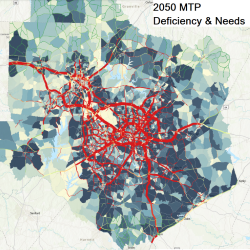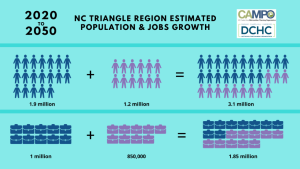2050 MTP Development
Latest: 2050 Metropolitan Transportation Plan - Adopted
2050 Maps and Projects List - Approved
Winter of 2021: Following additional guidance from the Executive Board at their fall meetings, in response to fiscal analysis conducted on the Preferred Scenario, the Draft 2050 MTP Maps and Projects List were produced for public review and feedback. They were subsequently approved by the Executive Board on December 8, 2021. The information below describes the process that led to production of the Draft.
Preferred Scenario
In September of 2021, the CAMPO Executive Board gave guidance on what to include in a Preferred Scenario so that staff could begin a fiscal analysis and develop a first draft of the 2050 MTP. By the end of October, staff produced a Draft 2050 MTP for public review and comment. This included a set of maps for transit, roadways, and bicycle/pedestrian infrastructure, as well as a list of roadway projects broken into 10-year horizon buckets (2021-2030; 2031-2040; 2041-2050). The public comment period was from October 28 - December 8, 2021. During that time, CAMPO staff incorporated feedback from local jurisdictions and regional, and state partners, as well.
- Public Comments - Compiled - Updated Dec. 8, 2021
Leading up to the Draft Plan, CAMPO staff completed the development and modeling associated with the Deficiencies and Needs of our anticipated 2050 transportation network, as well as three (3) transportation system alternative future scenarios (described further below) that were considered and analyzed to help determine what should be included in a Preferred Scenario for the 2050 MTP. With the Goals and Objectives that were set in 2020 as a guide, the deficiency analysis served as a baseline to create the three alternative scenarios to meet anticipated future travel demand.
This Preferred Scenario (based on the All Together scenario) increases the intensity and mix of land uses at major employment hubs and travel corridors, and works to link minority, low-income, and zero-car households to jobs. It increases biking and walking facilities and provides transit services in major commuting corridors and major activity centers. It assumes several future transportation funding changes on the state and local level, which means both housing affordability and transportation funding actions by a range of partners would be necessary. It also assumes that a larger proportion of residential and employment development occurs in the corridors served by bus, Bus Rapid Transit (BRT), Commuter Rail (CRT), and bicycle and pedestrian facilities. This scenario includes the highest density with mixed use land development, which increases transit usage to reduce Vehicle Miles Traveled. It also has the highest funding level among the alternative scenarios that were compared. More info...
Alternatives Analysis
Three (3) scenarios demonstrating potential futures for the Triangle region's transportation system were developed and modeled. Each scenario was evaluated against performance measures tied to the eight (8) goals which were approved by the CAMPO and DCHC MPO Boards earlier in the MTP Development process. At the conclusion of the alternatives analysis phase, decisions regarding which scenario attributes to carry forward into a “preferred’ plan (similar to a final draft) were made. Community input was a critical step in providing a public voice during the alternatives analysis phase. Learn more...
Details on the Alternative Scenarios
Deficiency & Needs Analysis 
The MPO staff has begun development of updated draft scenario alternatives for the 2050 Metropolitan Transportation Plan (2050 MTP/CTP). The first of these scenarios is known as the Deficiency Analysis. This is a baseline scenario for the future that is used to help analyze the various scenarios we use in the upcoming Alternatives Analysis stage. The Deficiency Analysis includes our future projected growth with only our existing and committed transportation network and is used to help inform our forecasts for population, employment, and travel changes between today and our ultimate 2050 horizon year during the Alternatives Analysis. Maps and More...
Deficiency & Needs ("Baseline") Analysis
Demand Modeling
The Triangle Regional Model (TRM) is a travel demand forecasting tool for the Triangle region of North Carolina. As part of the 2050 MTP process, the Capital Area MPO, DCHC MPO, GoTriangle, and NCDOT have developed an updated version of the Triangle Regional Travel Demand Model (TRM v6). More...
Socio-Economic Guide Totals 
One of the initial critical steps in developing a Metropolitan Transportation Plan is to forecast the amount, type and location of population and jobs for the time frame of the plan, known as Socio-Economic (SE) Guide Totals. Based on an understanding of community plans and data from local jurisdictions, the Office of State Planning, the US Census Bureau and independent forecasters, estimates of “base year” (2016) and “plan year” (2050) population and jobs were developed by local planners for each of the 1,701 small zones (called Traffic Analysis Zones or TAZs) that make up the area covered by our region’s transportation model.
The SE Guide Totals are broken into 1) Population Guide Totals, and 2) Employment Guide Totals.
In October 2020, CAMPO's Executive Board reviewed and approved the socio-economic data and totals for use in development of the plan. At a later step in the 2050 Metropolitan Transportation Plan process, the Executive Board will approve the final SE Data with the Preferred Option (for the 2050 MTP).
Goals & Objectives 
In the summer of 2020, CAMPO and DCHC MPO conducted a survey to gauge community support for eight (8) proposed goals and their related objectives. That survey closed on August 13, 2020. Over 2,000 people participated in the survey and almost one-third of respondents added comments to their responses.
2050 Goals + Objectives - Approved
Comments Received
A presentation on the survey results was shared with the Executive Board at their meeting on August 19, 2020. A summary will be included in the final 2050 MTP report, and all comments are linked below. Also included below are a set of 11 comments submitted in writing to either MPO during the public comment period.
- Written public comments (non-survey)
- Survey: General Suggestions for Goals
- Survey: Goal 1 Environment & Climate Change
- Survey: Goal 2 - Connect People & Places
- Survey: Goal 3 - Multimodal & Affordable
- Survey: Goal 4 - Congestion & Reliability
- Survey: Goal 5 - Infrastruction & Resilience
- Survey: Goal 6 - Equity & Participation
- Survey: Goal 7 - Safety & Health
- Survey: Goal 8 - Economic Vitality
